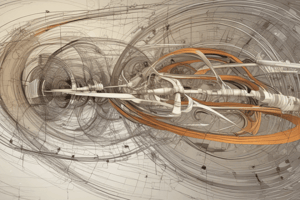Podcast
Questions and Answers
Which of the following best describes inertia?
Which of the following best describes inertia?
- The energy an object possesses due to its position.
- The property of a mass to resist changes in its state of motion. (correct)
- The force required to start an object's motion.
- A measure of how fast an object is moving.
According to Newton's first law of motion, what happens to a body if no external net force acts upon it?
According to Newton's first law of motion, what happens to a body if no external net force acts upon it?
- It will eventually come to a stop, regardless of its initial state.
- It will accelerate uniformly.
- It will change direction randomly.
- It will remain at rest or continue its uniform motion in a straight line. (correct)
When is work considered to be zero, even if a force is applied?
When is work considered to be zero, even if a force is applied?
- When the object moves at a constant speed.
- When the object does not move through a distance. (correct)
- When the force applied is very small.
- When the force is applied for a very short time.
Which of the following accurately describes the relationship between work and power?
Which of the following accurately describes the relationship between work and power?
If a machine does 1000 joules of work in 2 seconds, what is its power output in watts?
If a machine does 1000 joules of work in 2 seconds, what is its power output in watts?
According to the law of conservation of energy, which statement is correct?
According to the law of conservation of energy, which statement is correct?
A book is resting on a table. Which type of energy does it possess?
A book is resting on a table. Which type of energy does it possess?
Which of the following scenarios primarily involves kinetic energy?
Which of the following scenarios primarily involves kinetic energy?
A ball is thrown upwards. Ignoring air resistance, at what point in its trajectory is the potential energy at its minimum?
A ball is thrown upwards. Ignoring air resistance, at what point in its trajectory is the potential energy at its minimum?
A box slides down a ramp at a constant speed. Which of the following statements best describes the energy transformation taking place?
A box slides down a ramp at a constant speed. Which of the following statements best describes the energy transformation taking place?
In a system where a box is pushed across a rough surface, which of the following is NOT a direct consequence of friction?
In a system where a box is pushed across a rough surface, which of the following is NOT a direct consequence of friction?
A car is moving at a constant velocity. Suddenly, the driver applies the brakes, causing the car to slow down and eventually stop. What happens to the car's kinetic energy?
A car is moving at a constant velocity. Suddenly, the driver applies the brakes, causing the car to slow down and eventually stop. What happens to the car's kinetic energy?
Which of the following scenarios would result in the lowest amount of static friction?
Which of the following scenarios would result in the lowest amount of static friction?
How does lubrication reduce friction between two moving surfaces?
How does lubrication reduce friction between two moving surfaces?
A machine is designed to lift heavy objects. Due to friction in its moving parts, the actual work output is less than the energy input. Which of the following modifications would most likely increase the machine's efficiency?
A machine is designed to lift heavy objects. Due to friction in its moving parts, the actual work output is less than the energy input. Which of the following modifications would most likely increase the machine's efficiency?
Two objects have different masses and are moving at different velocities. Which of the following statements accurately describes the comparison of their linear momenta?
Two objects have different masses and are moving at different velocities. Which of the following statements accurately describes the comparison of their linear momenta?
Flashcards
Inertia
Inertia
The property of a mass to resist changes in its state of motion.
Newton's First Law
Newton's First Law
A body at rest stays at rest, and a body in motion stays in motion, unless acted upon by an external net force.
Work
Work
When a force acts on an object, overcomes inertia, and sets it in motion.
Power
Power
Signup and view all the flashcards
Energy
Energy
Signup and view all the flashcards
Law of Conservation of Energy
Law of Conservation of Energy
Signup and view all the flashcards
Potential Energy
Potential Energy
Signup and view all the flashcards
Kinetic Energy
Kinetic Energy
Signup and view all the flashcards
Conservation of Energy
Conservation of Energy
Signup and view all the flashcards
Friction
Friction
Signup and view all the flashcards
Coefficient of Friction (μ)
Coefficient of Friction (μ)
Signup and view all the flashcards
Types of Friction
Types of Friction
Signup and view all the flashcards
Efficiency
Efficiency
Signup and view all the flashcards
Linear Momentum
Linear Momentum
Signup and view all the flashcards
Study Notes
Dynamics
- Dynamics is the study of forces and their effects on motion
Inertia
- Inertia is the property of mass that resists changes in its state of motion
- The larger the mass, the greater the inertia
Newton's First Law of Motion
- A body remains at rest or continues in uniform motion until acted upon by an external net force
Work
- Work is done when a force acts on an object, overcomes inertia, and sets it in motion
- If the object does not move through a distance, the work done is zero
- Work (W) = Force (F) x Distance (S)
- The SI unit of work is the joule, equal to 1 Newton metre (Nm)
- In the Imperial system, work is measured in foot-pounds, which is the effort to raise one pound of mass by one foot
Power
- Power is the rate of doing work
- Time required to do work is not considered when determining the amount of work done, but power considers time
- The SI unit of power is the watt
- One watt is the power generated when one joule of work is done in one second
- In the Imperial system, power is expressed in foot/pounds per second
- One horsepower is equivalent to 550 foot/pounds per second and 746 Watts
- Power = force x distance / time
Energy
- Energy provides the capacity for work to be done and effect change
- The SI unit of energy is the joule
- Energy can neither be created nor destroyed, only changed from one form to another (law of conservation of energy)
- A car converts the chemical energy in petrol into mechanical energy, heat, and sound
Potential Energy
- Potential energy is the stored energy in a body due to its position, condition, or chemical nature
- Hydroelectric power uses the potential energy stored in a mass of water flowing downhill
Kinetic Energy
- Kinetic energy is the energy a body possesses because of its motion
- When a body held aloft falls, its potential energy is converted to kinetic energy
Total Energy
- The total energy does not change, but potential energy can be transformed into kinetic energy and vice-versa
- A falling mass has maximum potential energy at its highest elevation
- Halfway through its fall, the potential energy equals the kinetic energy
- The kinetic energy is maximum the instant the body strikes the floor
- Potential energy is zero when there is no distance left to fall
Friction
- Friction is the resistance to motion when objects roll or slide in contact with each other
- Minimizing friction is sought using lubricant in most industrial applications
- The coefficient of friction (μ) indicates the differences in friction between materials
Types of Friction
- Starting or Static: Overcoming initial resistance until breakaway
- Sliding: Resistance during steady motion
- Rolling: Single point contact resistance, less than sliding, requires some friction for grip
Heat
- Heat is a useful form of energy directly related to work and the use of engines
- Heat results due to friction
Efficiency
- The efficiency of machinery is the ratio of work output to worker energy input
- Friction primarily determines the efficiency of a machine
- Friction creates energy losses as heat, sound, and sometimes light
- Reducing friction occurs by lubrication or streamlining
Momentum
- Momentum is the product of inertia and the motion it already has, namely the tendency of a mass to resist change in its state of motion
- Two types of momentum: linear and angular
Linear Momentum
- Linear momentum measures the tendency of a moving body to continue in motion along a straight line
- Momentum is defined as the product of the mass and velocity of a body
Angular Momentum
- Angular momentum measures the tendency of a rotating body to continue spinning about an axis
Impulse
- Impulse results when a force affects the motion of an object
- Impulse is the amount of change in momentum; equal to the force multiplied by time (I = Ft)
Gyroscope
- A gyroscope is any rotating mass whose supporting platform or case can be turned in one or more planes around the rotor without changing the rotor's plane of rotation
- Fundamental characteristics are gyroscopic inertia (rigidity in space) and precession
Gyroscopic Rigidity
- This this property of any rotating mass to resist changes to its plane of rotation unless an external force causes a change
Precession
- Is the the change of the plane of rotation caused by an external force
Studying That Suits You
Use AI to generate personalized quizzes and flashcards to suit your learning preferences.





